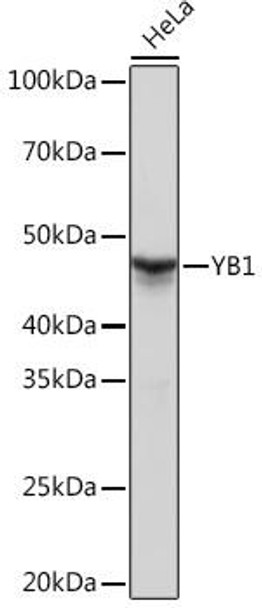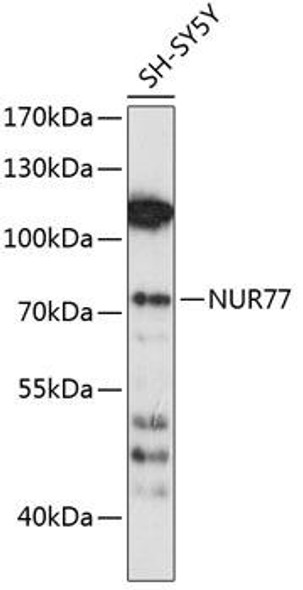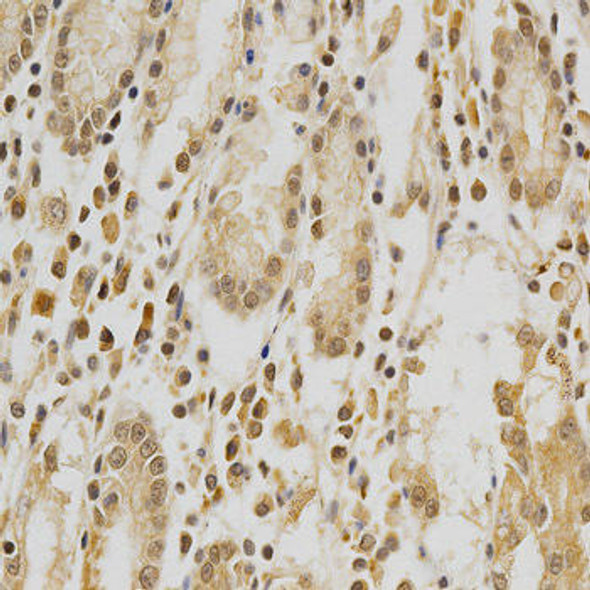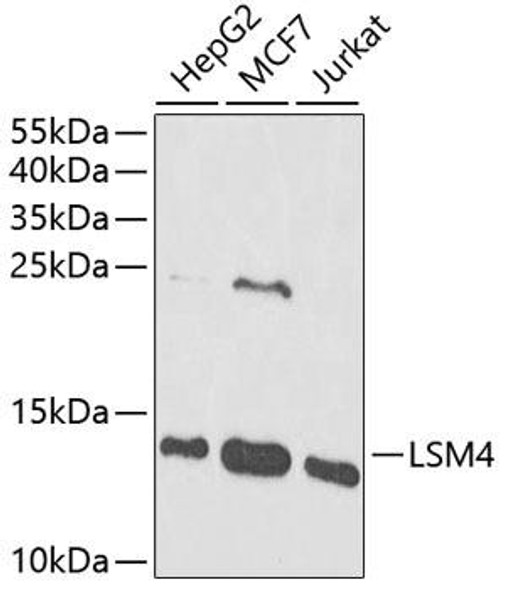Description
Anti-YB1 Antibody (CAB3534)
The YB1 Rabbit Monoclonal Antibody (CAB3534) is a valuable tool for researchers studying the YB1 protein, a multifunctional protein involved in various cellular processes such as DNA repair, RNA transcription, and translation regulation. This antibody, generated from rabbits, exhibits high specificity and sensitivity towards human samples, making it an excellent choice for Western blot analysis.YB1, also known as Y-box binding protein 1, is a key player in gene expression regulation and has been implicated in cancer progression, drug resistance, and metastasis.
By targeting the YB1 protein, researchers can gain insights into its role in tumorigenesis and potentially identify novel therapeutic targets for cancer treatment.With its ability to detect YB1 protein in a variety of cell types, the YB1 Rabbit Monoclonal Antibody is a valuable tool for studies in molecular biology, oncology, and pharmacology. Its versatility and reliability make it an essential reagent for uncovering the intricate mechanisms underlying YB1-mediated cellular processes.
| Antibody Name: | Anti-YB1 Antibody |
| Antibody SKU: | CAB3534 |
| Antibody Size: | 20uL, 50uL, 100uL |
| Application: | WB IHC IF |
| Reactivity: | Human, Mouse, Rat |
| Host Species: | Rabbit |
| Immunogen: | A synthesized peptide derived from human YB1 |
| Application: | WB IHC IF |
| Recommended Dilution: | WB 1:500 - 1:2000 IHC 1:50 - 1:200 IF 1:50 - 1:200 |
| Reactivity: | Human, Mouse, Rat |
| Positive Samples: | Mouse testis, Rat heart, HeLa |
| Immunogen: | A synthesized peptide derived from human YB1 |
| Purification Method: | Affinity purification |
| Storage Buffer: | Store at -20'C. Avoid freeze / thaw cycles. Buffer: PBS with 0.02% sodium azide, 0.05% BSA, 50% glycerol, pH7.3. |
| Isotype: | IgG |
| Sequence: | Email for sequence |
| Gene ID: | 4904 |
| Uniprot: | P67809 |
| Cellular Location: | |
| Calculated MW: | 50kDa |
| Observed MW: | 49KDa |
| Synonyms: | BP-8, CBF-A, CSDA2, CSDB, DBPB, EFI-A, MDR-NF1, NSEP-1, NSEP1, YB-1, YB1 |
| Background: | This gene encodes a highly conserved cold shock domain protein that has broad nucleic acid binding properties. The encoded protein functions as both a DNA and RNA binding protein and has been implicated in numerous cellular processes including regulation of transcription and translation, pre-mRNA splicing, DNA reparation and mRNA packaging. This protein is also a component of messenger ribonucleoprotein (mRNP) complexes and may have a role in microRNA processing. This protein can be secreted through non-classical pathways and functions as an extracellular mitogen. Aberrant expression of the gene is associated with cancer proliferation in numerous tissues. This gene may be a prognostic marker for poor outcome and drug resistance in certain cancers. Alternate splicing results in multiple transcript variants. Pseudogenes of this gene are found on multiple chromosomes. [provided by RefSeq, Sep 2015] |
| UniProt Protein Function: | YB-1: a nuclear protein that binds to splice sites in pre-mRNA and regulates splice site selection. Binds and stabilizes cytoplasmic mRNA. Contributes to the regulation of translation by modulating the interaction between the mRNA and eukaryotic initiation factors CCAAT-containing Y-box of HLA class II genes. Component of cytoplasmic messenger ribonucleoprotein particles (mRNPs). Interacts with AKT1, SFRS9, THOC4, MSH2, XRCC5, WRN and NCL. Can bind to DNA as a homomeric form, (EFI-A)n or as a heteromeric form in association with EFI-B. Homodimer in the presence of ATP. Involved in cisplatin resistance. Seems to be a negative regulatory factor. May play a role in both transcriptional and translational regulation of spermatogenesis. Found at very low levels at day 10 and levels increase at day 15 and persist throughout adulthood. |
| UniProt Protein Details: | Protein type:Transcription factor; RNA-binding; RNA splicing; RNA processing Chromosomal Location of Human Ortholog: 1p34 Cellular Component: nucleoplasm; nuclear membrane; intracellular membrane-bound organelle; stress granule; cytoplasm; nucleus; ribonucleoprotein complex; U12-dependent spliceosome Molecular Function:protein binding; DNA binding; RNA binding; double-stranded DNA binding; transcription factor activity; single-stranded DNA binding Biological Process: transcription from RNA polymerase II promoter; nuclear mRNA splicing, via spliceosome; negative regulation of striated muscle cell differentiation; regulation of transcription, DNA-dependent; in utero embryonic development; positive regulation of cell division; RNA splicing; positive regulation of transcription from RNA polymerase II promoter; gene expression; negative regulation of transcription from RNA polymerase II promoter |
| UniProt Code: | P67809 |
| NCBI GenInfo Identifier: | 34098946 |
| NCBI Gene ID: | 4904 |
| NCBI Accession: | NP_004550.2 |
| UniProt Secondary Accession: | P67809,P16990, P16991, Q14972, Q15325, Q5FVF0, |
| UniProt Related Accession: | P67809 |
| Molecular Weight: | 35,924 Da |
| NCBI Full Name: | nuclease-sensitive element-binding protein 1 |
| NCBI Synonym Full Names: | Y box binding protein 1 |
| NCBI Official Symbol: | YBX1 |
| NCBI Official Synonym Symbols: | YB1; BP-8; CSDB; DBPB; YB-1; CSDA2; NSEP1; NSEP-1; MDR-NF1 |
| NCBI Protein Information: | nuclease-sensitive element-binding protein 1; CBF-A; EFI-A; DNA-binding protein B; Y-box-binding protein 1; Y-box transcription factor; enhancer factor I subunit A; nuclease sensitive element binding protein 1; CCAAT-binding transcription factor I subunit |
| UniProt Protein Name: | Nuclease-sensitive element-binding protein 1 |
| UniProt Synonym Protein Names: | CCAAT-binding transcription factor I subunit A; CBF-A; DNA-binding protein B; DBPB; Enhancer factor I subunit A; EFI-A; Y-box transcription factor; Y-box-binding protein 1 |
| Protein Family: | Nuclease-sensitive element-binding protein |
| UniProt Gene Name: | YBX1 |
| UniProt Entry Name: | YBOX1_HUMAN |
 | Western blot analysis of extracts of HeLa cells, using YB-1/YBX1 Rabbit mAb at 1:1000 dilution. Secondary antibody: HRP Goat Anti-Rabbit IgG (H+L) at 1:10000 dilution. Lysates/proteins: 25ug per lane. Blocking buffer: 3% nonfat dry milk in TBST. Detection: ECL Basic Kit. Exposure time: 1s. |
 | Western blot analysis of extracts of various cell lines, using YB-1/YBX1 Rabbit mAb at 1:1000 dilution. Secondary antibody: HRP Goat Anti-Rabbit IgG (H+L) at 1:10000 dilution. Lysates/proteins: 25ug per lane. Blocking buffer: 3% nonfat dry milk in TBST. Detection: ECL Basic Kit. Exposure time: 10s. |
 | Immunohistochemistry of paraffin-embedded rat brain using YB-1/YBX1 Rabbit mAb at dilution of 1:100 (40x lens). Perform microwave antigen retrieval with 10 mM PBS buffer pH 7. 2 before commencing with IHC staining protocol. |
 | Immunohistochemistry of paraffin-embedded human oophoroma using YB-1/YBX1 Rabbit mAb at dilution of 1:100 (40x lens). Perform microwave antigen retrieval with 10 mM PBS buffer pH 7. 2 before commencing with IHC staining protocol. |
 | Immunohistochemistry of paraffin-embedded mouse brain using YB-1/YBX1 Rabbit mAb at dilution of 1:100 (40x lens). Perform microwave antigen retrieval with 10 mM PBS buffer pH 7. 2 before commencing with IHC staining protocol. |
 | Immunofluorescence analysis of C6 cells using YB-1/YBX1 Rabbit mAb at dilution of 1:100 (40x lens). Blue: DAPI for nuclear staining. |
 | Immunofluorescence analysis of NIH-3T3 cells using YB-1/YBX1 Rabbit mAb at dilution of 1:100 (40x lens). Blue: DAPI for nuclear staining. |
 | Immunofluorescence analysis of U-2 OS cells using YB-1/YBX1 Rabbit mAb at dilution of 1:100 (40x lens). Blue: DAPI for nuclear staining. |
 | Immunoprecipitation analysis of 300ug extracts of HeLa cells using 3ug YB-1/YBX1 antibody at a dilition of 1:1000. |
 | Chromatin immunoprecipitation analysis of extracts of MCF7 cells, using YB-1/YBX1 antibody and rabbit IgG. The amount of immunoprecipitated DNA was checked by quantitative PCR. Histogram was constructed by the ratios of the immunoprecipitated DNA to the input. |










